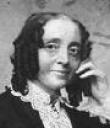Ernestine Louise Siismondi Potowski Rose 1810 - 1882
December 03, 2007
 Ernestine
Rose* 1810 - 1882 was a
close
friend
of homeopathic supporters Elizabeth Cady
Stanton,
Susan B
Anthony,
Angelina Grimke
Weld,
Antionette Brown
Blackwell and
Lucy
Stone.
Together they founded the National Women’s Loyal
League,
and the National Woman Suffrage
Association.
Ernestine
Rose* 1810 - 1882 was a
close
friend
of homeopathic supporters Elizabeth Cady
Stanton,
Susan B
Anthony,
Angelina Grimke
Weld,
Antionette Brown
Blackwell and
Lucy
Stone.
Together they founded the National Women’s Loyal
League,
and the National Woman Suffrage
Association.
Elizabeth Cady Stanton explains:
Ernestine L. Rose, Paulina Wright (Davis), and I had spoken before committees of the legislature years before, demanding equal property rights for women. We had circulated petitions for the Married Woman’s Property Bill for many years, and so also had the leaders of the Dutch aristocracy, who desired to see their life-long accumulations descend to their daughters and grandchildren rather than pass into the hands of dissipated, thriftless sons-in-law.
Rose supported herself by marketing an “aromatherapy” air-freshening device of her own making. Finally settling in England, she met utopian socialist Robert Owen and became one of his disciples. In 1832 or 1836 (the sources vary) she married London jeweler William E. Rose, a protestant member of the group, and together with a few others they immigrated to the United States.
Rose was influenced by Robert Owen, (who referred to her as ‘my daughter’) when she was in England and they became close friends. Under his influence, Rose helped to establish the Association of All Classes of All Nations. Robert Owen’s eclectic mix of philosophy spread World Wide at this time, and homeopathy was transmitted at the same time.
Robert Owen brought a colony of educators, artists, and scientists to southwestern Indiana:
John Clare, William Wordsworth, Percy Bysse Shelley, Lord Byron, John Keats, Constable, Samuel Taylor** **Coleridge, Friedrich, Turner, Robert Owen, John Ruskin and William Morris are also profoundly typical of Romance… The environmental thing is also an expression of Romanticism. Homeopathy and all alternative therapies also show clear links with the Romantic tradition…
In the case of homeopathy, it arises as a queer mix of science and romanticism. Religious belief seems to be confirmed by homeopathy and that is perhaps one reason why it was very popular with clerics in all countries and the preferred medical system amongst their kind. That can and did go both ways - towards traditional Christianity and towards pagan beliefs. continue reading:
When the World’s Anti-Slavery Convention, which met in London in 1840, excluded female delegates, it was the Quaker teacher Sarah Pugh, a representative from the Philadelphia Female Anti-Slavery Society, who wrote the protest and Lucretia Mott who led the public attack on the policy. Pugh would go on to hold the office of President in the Society for most of its duration (1833-1870), and along with Mary Grew was one of the most active members.
A close friend, along with Susan B. Anthony, Lucretia Mott and Ernestine Rose, Pugh was also a grand-aunt and a role model for the social reformer, Florence Kelley.
Mott, Elizabeth Cady Stanton, Susan B Anthony, Lucy Stone, Antionette Brown, Martha Coffin Brown (Wright) (Mott’s sister), Henry B Blackwell (Lucy Stone’s husband), Elizabeth Smith Miller (Elizabeth Cady Smith’s cousin), Amelia Bloomer and Ernestine L Rose formed the Ultras Circle and spoke at annual women’s rights conventions during 1848 and 1860.
In 1869, both Stanton and Anthony left the American Equal Rights Association, and Rose and her English husband moved permanently back to England. Anthony secured “a handsome sum of money and a number of presents for her” as a tribute to honor her before her departure.
Rose did come back to the United States in 1873 for a meeting ot the National Woman Suffrage Association. However, she wanted nothing published about herself and refused an offer in 1877 from Anthony to write a portion of the History of Woman Suffrage.
After her death in Brighton England on August 4, 1892, Stanton and Anthony saw to it that she was given her appropriate place in history.
Rose was the author of the pamphlet Defense of Atheism which was one of the freethought pamphlets in circulation in the early times of The Truth Seeker. J. M. Wheeler, of the London Freethinker, wrote that only six weeks before her death she presented him with a copy of that work and said she had nothing to alter.
Note: In 1920 another woman named Ernestine Rose became a staunch defender of equal rights and:
Rose was also a staunch defender of American Black people, whom she employed at the New York Public Library, and she stated that she intended to establish a ‘Black City’ and she organised a display of Negro Art there. Rose also presided over discussions groups for Black literature and poetry readings by Black authors.
Rose supported Nella Imes Larsen, the first black librarian to graduate from library school at Columbia University. Rose was also a committed defender of Jewish rights at the library.
I have not been able to discover much about this second Ernestine Rose, but I do feel she deserves a mention here. Working with Arthur A Schomburg, this Ernestine Rose helped a great number of people, including Pura Belpre, Catherine Allen Latimer and many others.